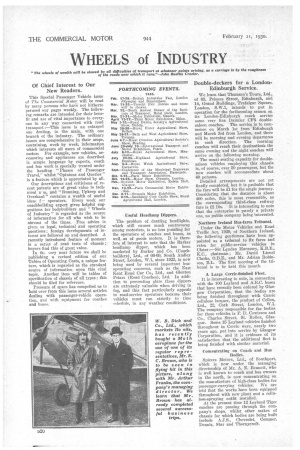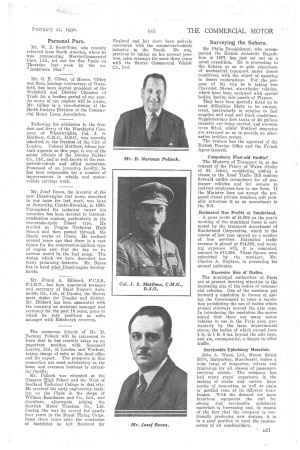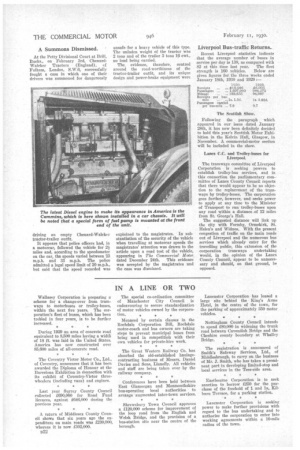WHEELS of INDUSTRY "The wheels of wealth will be slowed
Page 98

Page 99

Page 100

Page 101

If you've noticed an error in this article please click here to report it so we can fix it.
by all difficulties of transport at whatever points arising, as a carriage is by the roughness of the roads over which it runs,"—John Beattie Crozier.
Of Chief Interest to Our New Readers.
This Special Passenger Vehicle issue of The Commercial Motor will be read by many persons who haVe not hitherto Perused our pages weekly. The following remarks are intended for their benefit and ale of vital importance to everyone in any way connected with road transport :—This issue is an enlarged one dealing, in the main, with one branch of the industry. The ordinary issues are comprehensive in their scope, containing, week by week, information which interests all users of commercial motor-. For example, new vehicles, accessories and appliances are described in simple language by experts, coach and bus work is specially treated under the heading "Phases of Passenger Travel," whilst "Opinions and Queries" is a feature which is appreciated by alt.
Our descriptions and criticisms of recent patents are of great value to technical n m, and "Running, Upkeep and Overhaul" contains a wealth of useful ideto_ f operators. Every week our coachbuilding expert gives helpful suggestions for bodybuilders and "Wheels of Industry" is regarded as the source of information for all who wish to be abreast of the times. Free advice is given on legal, technical and operating questions ; foreign developments of interest are followed up and described. A recently introduced feature of moment is a series of road tests of chassis ; buyers find this of great value.
In th:. very near future we shall be publishing a revised edition of our Tables of Operating Costs, a unique feature, which is regarded as the standard source of information upon this vital topic. Another item will be tables of specification of chassis of all types ; this should be filed for reference.
Pressure of space has compelled us to hold over from this issue several articles dealing with passenger-vehicle operation, and with equipment for coaches and buses. Useful Headlamp Dippers. • The problem of dazzling headlights, which still causes much controversy among motorists, is no less puzzling for the operators of coaches and buses, as well as of goods motors. It is therefore of interest to note that the Barker headlamp dipper, which has been marketed by Barker and Co. (Coachbuilders), Ltd., of 66-69, South Audley Street, London, W.1, since 1923, is now being used by several important busoperating concerns, such as the East Kent Road Car Co., Ltd., and Glenton Friars (Road Coaches), Ltd. In addition to preventing glare these dippers are extremely valuable when driving in fog, and this fact particularly appeals to road-service operators because their vehicles must run strictly to time schedule, in any weather conditions.
Double-deckers for a LondonEdinburgh Service.
We learn that Thomson's Tours, Ltd., of 63, Princes Street, Edinburgh, and 14, Grand Buildings, Trafalgar Square, London, S.W.1, intends to put in operation for the forthcoming season on its London-Edinburgh coach service some very fine Daimler CF6 doublesaloon coaches. The service is to commence on March 1st from Edinburgh and March 3rd from London, and there will be morning and evening departures in each direction. The morning coaches will reach their destination's the same evening and the night coaches will arrive on the following morning.
The usual seating capacity for doublesaloon vehicles employing this chassis is, of course, over 50 passengers, but the new coaches will accommodate about 40 persona. Detailed arrangements are not yet finally completed, but it is probable that the fare will be £1 for the single journey. Considering that the distance is about 400 miles, this is most reasonable, •as the corresponding third-class .railway fare is £2 10s. It is interesting to note that the enterprise is purely a private one, no public company being interested.
Northern Ireland Bus-fares Tribunal. Under the Motor Vehicles and Road Traffic Act, 1929, of Northern Deland, the following gentlemen have been appointed as a tribunal to fix fares and rates for public-service vehicles in Ulster :—Sir Lynden Macassey, K.B.E., KC., chairman ; Mr. David Lienel Clarke, 0.B.E., and Mr. Adrian Robinson, B.L. The first meeting of the tribunal is to be held this month.
A Large Cerrie-finished Fleet.
It is interesting to note, in connection with the 100 Leyland and A.E.C. buses that have recently been ordered by Glasgow Corporation, that the bodies are being finished throughout with Cerric cellulose lacquer, the product of Cellon, Ltd., 22, Cork Street, London, W.1. The company responsible for the bodies for these vehicles is F. D. Cowieson and Co., Charles Street, St. Rollox, Glasgow. Some 15 Leyland vehicles finished throughout in Cerric were, nearly two years ago, put into service by Glasgow Corporation, and it is evidence of its satisfaction that the additional fleet is being finished with similar material.
Concentrating on Coach and Bus Bodies.
Spicers Motors, Ltd., of Southport, which is now under the managing directorship of Mr. A. E. Bennett, who is well known to coach and bus owners in the north, is now concentrating on the manufacture of high-class bodies for passenger-carrying vehicles. We are told that the works have been equipped throughout with new plant and a cellulose-spraying outfit installed.
At the present time 12 Leyland Tiger coaches are passing through the cornpany's shops, whilst other makes of chassis for which bodies are being built include A.j.S., Chevrolet, Commer, Dennis, Star and Thornyeroft. Personal Pars.
Mr. W. J., Scott-Tute, who recently returned from South America, where he -was representing Morris-Commercial Cars, Ltd., set out for Sao Paulo on Thursday last week by the s.s. "Andalucia Star.'."
Mr. G. E. Gilbey, of Messrs. Gilbey and Sons, haulage contractors, of Wakefield, has been elected president of the Wakefield and District Chamber of Trade for a further period of one year. As many of our readers will be aware, Mr. Gilbey is a vice-chairman of the North-Eastern Division of the Commercial Motor Users Association.
Following his admission to the freedom and livery of the Worshipful Company of Wheelwrights, Col. J. S. Matthew, C.M.G., D.S.O., was recently admitted to the freedom of the City of London. Colonel Matthew, whose portrait appears on this page; is one of the senior officials of the Dunlop Rubber Co., Ltd., and is well known in the commercial-vehicle and allied industries. Possessed of an inventive faculty, he has been responsible for a number of improvements in wheels and motorvehicle carriage work.
Mr. Josef Benes, the inventor of the licw Diesel-engine fuel pump described in our issue for last week, was born at Javorniky, Czecho-Slovakia, in 1896. Throughout his technical career his attention has been devoted to internalcombustion engines, particularly to the two-stroke-cycle Diesel type. He Etudied at Prague Technical High School and then passed through the Skoda works at Pilsen. He realized several. years ago that there is a vast future for the compression-ignition type of engine and that the key to its success would be the fuel pump. The design which we have described has many promising features. Mr. Benes
has in hand other Diesel-engine develop_ _ meats.
Mr. Frank A. Hibberd, F.C.I.S., F.I./41.T., has been appointed manager and secretary of Saint Roque's Automobile Co., Ltd., of Dundee, the Morris main dealer for Dundee and district. Mr. Ilibberd has been associated with the company as assistant manager and secretary for the past 10 years, prior to which he held positions as sales manager with Edinburgh concerns.
The numerous friends of Mr. D. Norman Pollock will be interested to learn that he has recently taken up an important position with Seammell Lorries, Ltd., of London and Watford, taking charge of sales at the head office and for export. The prospects in this connection are most satisfactory as the home and overseas business is extending rapidly.
Mr. Pollock was educated at the Glasgow High School and the West of Scotland Technical College in that city. He received his early engineering training on the Clyde in the shops of William Beardmore and Co., Ltd., and elsewhere, afterwards joining the Scottish Motor Traction Co., Ltd. During the war he served for nearly four years in the Royal Flying Corps. Some three years after the conclusion of hostilities he left Scotland for
England and has since been actively associated with the commercial-vehicle industry in the South. He was, previous to taking up his present position, sales manager for some three 3-ears with the Saurer Commercial Vehicle Co., Ltd. Surveying the Sahara.
Sir Philip Brocklehurst, who accompanied the British Antarctic Expedition in 1907, has just set out on a novel expedition. He is proceeding to the Sahara so as to gain experience of mechanical transport under desert conditions, with the object of assisting in desert explorations. For the purpose of his trip he is taking two Chevrolet 30-cwt. six-cylinder vehicles, which have been equipped with special bodies, having side panels of Plymax. They have been specially fitted up to meet difficulties likely to be encountered, particularly in relation to fuel supplies and road and track conditions. Supplementary fuel tanks of 40 gallons capacity are being carried, and oversize tyres fitted, whilst Watford magnetos are arranged so as to provide an alternative ignition system.
The venture has the approval of the British Foreign Office and the French Agent-General.
Compulsory First-aid Outfits?
The Ministry of Transport is, at the request of the Priory of Wales (Order of St. John), considering adding a clause to the Road Traffic Bill making first-aid outfits compulsory for all passenger vehicles and for owners to Instruct employees how to use them. If the Ministry does not accept the proposed clause private members will probably introduce it as an amendment to the Bill.
Estimated Bus Profits at Sunderland.
A gross profit of £1,094 on the year's working of the municipal buses is estimated by the transport department of Sunderland Corporation, which in the course of last year opened up a number of bus services. Estimated traffie revenue is placed at £14,588, and working expenses will, it is computed, amount to £13,494. These figures were submitted by the manager, Mr. Charles A. Hopkins, in presenting his annual estimates.
Excessive Size of Bodies.
The municipal authorities of Paris are at present devoting attention to the increasing size of the bodies of commercial vehicles. One of the members put forward a resolution in favour of asking the Government to issue a regulation prohibiting the use of bodies which project sideways beyond the axle caps. In introducing the resolution the mover stated that there are many motor vehicles in use in the Paris area, particularly by the large departmental stores, the bodies of which extend from 1 ft. to 1 ft. 8 ins, beyond the axle caps, and are, consequently, a danger to other traffic.
Serviceable Upholstery Materials.
John A. Wood, Ltd. Mount Street Mills, Harpurhey, Manchester, makes a ride range of moquettes, velvets and trimmings for all classes of passengercarrying vehicle. The company has had many years' experience in the making of cloths and carries large stocks of moquettes, as well as plain or mottled reps, at its different warehouses. With •the demand for more luxurious equipment •the call for strong and serviceable upholstery materials is increasing and, by reason of the fact that the company is continually producing new, designs, it is in a good position to meet the requirements of all coachbuilders. A Summons Dismissed. •
At the Petty Divisional Court at Brill, Bucks., on February 3rd, ChenardWalcker Tractors (England), of Fulham, London. S.W.6, successfully fought a ease in which one of their drivers was summoned for dangerously driving an empty Chenard-Walcker tractor-trailer outfit.
It appears that police officers had, in a motorcar, followed the vehicle for 2i miles and, according to the speedometer on the car, the speeds varied between 23 m.p.h. and 33 m.p.h. The police admitted a legal speed limit of 20 m.p.h., but said that the speed recorded was
unsafe for a heavy vehicle of this type. The unladen weight of the tractor was 2 tons and of the trailer 3 tons 10 cwt., no load being carried.
The_ evidence, therefore, centred around the road-worthiness of the tractor-trailer outfit, and its unique design and power-brake equipment were explained to the magistrates. In substantiation of the security of the vehicle when travelling at motorcar speeds the magistrates' attention was drawn to the article upon a road test of the vehicle, appearing in The Commercial Motor. dated December 24th. This evidence was accepted by the magistrates and the case was dismissed.
Liverpool Bus-traffic Returns.
Recent Liverpool statistics indicate that the average number of buses in service per day is 138, as compared with 82 at this time last year. The fleet strength is 160 vehicles. Below are given figures for the' three weeks ended January 18th, 1930 and 1929 :—
1950.
Receipts ... £10,546 Passengers ... 1,507,090 946.272 Mileage ... 188,835 96,987 Receipts per bus mile .. ...1s. 1.5d. 1s. 2,851
Passengers carried
per bus-mile ... 7.9 9.7 The Scottish Show. Following the paragraph which
appeared in our issue dated January 28th, it has now been definitely decided to hold this year's Scottish Motor Exhibition in the Kelvin Hall, Glasgow, in November. A commercial-motor section will be included in the show.
Lanes C.C. and Trolley-buses for Liverpool.
The tramways committee of Liverpool Corporation is seeking powers to establish trolley-bus services, and in this connection the parliamentary committee of Lanes County Council reports that there would appear to be no objection to the replacement of the tramways by trolley-buses. The corporation goes further, however, and seeks power to apply at any time to the Minister of Transport to run trolley-buses upon any road within a distance of 12 miles from St. George's Hall.
The suggested distance will link up the city with Formby, Ormskirk, St. Helen's and Widnes. With the present congestion of traffic on the main roads out of Liverpool and the numerous bus services which already cater for the travelling public, this extension of the corporation tramways undertaking would, in the opinion of the Lanes County Council, appear to be unnecessary and should, on that ground, be opposed.
Water for Steam Wagons.
The Liverpool Area Committee of the C.M.U.A., will, on Thursday next, consider a report that the• scheme for the supply of water to steam wagons continues to operate successfully, but that damage is being done to the service boxes. Co-operation of steam-wagon owners is required.
Bomber's Busy.
Ti. Bamber and Co., Ltd., 33, Liverpool Road, Birkdale, Southport, informs us that it is at present executing, for early delivery, a large number of orders for coaches and buses. These are for over 70 new vehicles, amongst which are double-saloon buses for service in the metropolitan area and a fleet of Thornycroft 32-seaters for a well-known Lancashire user.
Specializing in Bus Equipment.
We are informed that G. D. Peters and Co., Ltd., has created a new department to deal with bus equipment of all descriptions. The company's demonstration bus which toured the country during last year aroused a good deal of interest and it successful mission has been largely responsible for the decision to open a new section. This will be supervised by Mr. A. C. Riley, who has had a long experience with all types of motor vehicle; particularly from the operating and maintenance points of view.
Fire Protection for Garages.
One day last week the Pyrene Co., Ltd" of 9, Grosvenor Gardens, London, S.W.1., held a striking demonstration of its widely used fire-fighting appliances. Three gallons of blazing motor spirit -were extinguished; then the foam and petrol in the tray were stirred and relighted ; the foam separated out and smothered the flames again. A twogallon Phomene extinguisher was used
• for this demonstration.
For the next test an F.G.N. 44 Phomene foam generator was employed. A circular tank with an area of 320 sq. ft,, contained one ton of furnace oil and petrol, which was ignited. A single nozzle delivered the foam on to the burning mass, which was extinguished in about one minute. These generators are made in a range of sizes producing 300 gallons to 12,300 gallons per charge of powder. They can be used in pairs in order to dis charge sirnintaneously or continuously. . The principle employed consists of arranging water jets to play upon the powder within the generator. Instantly the powder commences to go into solution and carbon dioxide gas is generated, the foam being ejected by chemical action. Recharging the generator can be effected whatever may be the wind and weather conditions.
Voran Front-wheel Drive.
In the issue of T he Commercial Motor dated March 26th, 1929, we described the Voran front-wheel-drive system. The principal licence for the manufacture of mechanisms under Voran patents has been acquired by David Brown and Sons (Huddersfield), Ltd., Park Works, Lockwood, Huddersfield, the well-known company of specialists in gearing of all patterns.
The concern is ready to produce complete drives for vehicles of any size and capacity or will grant sub-licences to
vehicle makers. The drive from the engine gearbox unit is taken through universally jointed shafts to the independently sprung front wheels.




























































































































































































































